 Malhado de Alcobaca
Malhado de Alcobaca
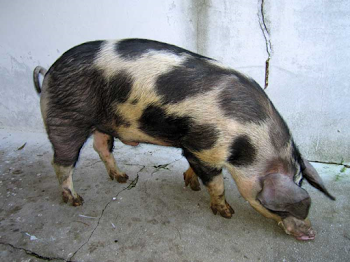 Malhado de Alcobaça pigs, a native Portuguese breed once feared to be extinct, have recently experienced a remarkable resurgence in numbers. This breed, characterized by its distinctive coloration and unique genetic heritage, has captured the attention of conservationists and pig enthusiasts alike.
Malhado de Alcobaça pigs, a native Portuguese breed once feared to be extinct, have recently experienced a remarkable resurgence in numbers. This breed, characterized by its distinctive coloration and unique genetic heritage, has captured the attention of conservationists and pig enthusiasts alike.
Hailing from the region of Alcobaça in Portugal, these pigs boast a rich history deeply intertwined with the cultural heritage of their homeland. Once on the brink of disappearance, concerted conservation efforts have breathed new life into the Malhado de Alcobaça population, ensuring its survival for future generations to appreciate and cherish.
Their resurgence is a testament to the resilience and adaptability of this vene ...

 Mangalica
Mangalica
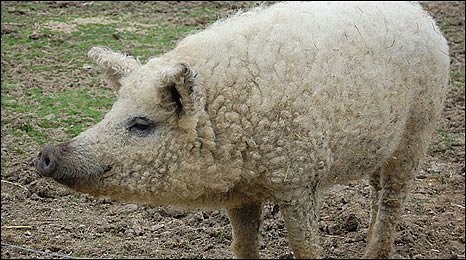 Mangalica Pigs (sometimes spelled Mangalitsa (USA) or
Mangalitza (UK)) is a Hungarian breed of pig that was developed in the 19th
century by cross-breeding the traditional Hungarian Bakonyi and Szalontai
breeds with imported Sumadia pigs from Serbia.
Mangalica Pigs (sometimes spelled Mangalitsa (USA) or
Mangalitza (UK)) is a Hungarian breed of pig that was developed in the 19th
century by cross-breeding the traditional Hungarian Bakonyi and Szalontai
breeds with imported Sumadia pigs from Serbia. Mangalitsa pigs have a thick hairy coat similar to that of a sheep. The only other pig breed noted for having a long coat is the extinct Lincolnshire Curly Coat of England.
The Mangalitsa is a lardpig, with a high fat content in the meat; they are large and round. Because of the drop in demand for lard, the popularity of the breed has declined and they are now regarded as a rare breed.

 Meishan
Meishan
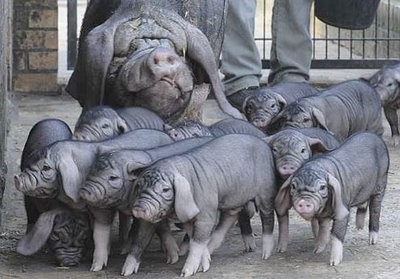 Meishan pigs are named for the
Chinese prefecture of Meishan. They are classified
as a type of Taihu pig which are all from the narrow region of mild
sub-tropical climate around the Taihu Lake region in Shanghai.
Meishan pigs are named for the
Chinese prefecture of Meishan. They are classified
as a type of Taihu pig which are all from the narrow region of mild
sub-tropical climate around the Taihu Lake region in Shanghai. Meishan pigs are small to medium-sized with large drooping ears and wrinkled black skin. They are best known for its large litters of 15-16 piglets. Due to their fecundity, they were introduced into the United States under a cooperative effort of the USDA, the University of Illinois, and Iowa State University. This effort also imported Fengjing and Minzhu pigs from China. A total of 144 pigs from these breeds were shipped to the United States. Iowa State University received 22 Meishan females and 10 Meishan bo ...

 Middle White Pig
Middle White Pig
 The Middle White Pig, a quintessential breed native to the United Kingdom, traces its roots back to Yorkshire, emerging around the same period as its counterparts, the Large White and the now-extinct Small White. The name "Middle White" aptly reflects its size, positioned between the larger Large White and the smaller Small White breeds.
The Middle White Pig, a quintessential breed native to the United Kingdom, traces its roots back to Yorkshire, emerging around the same period as its counterparts, the Large White and the now-extinct Small White. The name "Middle White" aptly reflects its size, positioned between the larger Large White and the smaller Small White breeds.
Formally recognized as a distinct breed in 1884, the Middle White Pig has established itself as a notable pork producer, distinguished for its proficiency in yielding pork rather than bacon or lard, in contrast to other swine breeds. One of its defining physical attributes is its sharply upturned snub nose, contributing to its distinctive appearance.
Known for their docile temperament, ...

 Minbei Spotted
Minbei Spotted
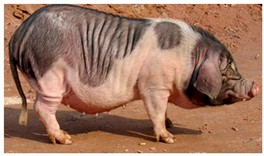 Minbei Spotted pigs, also known as Northwestern China Spotted pigs, are an indigenous breed of domestic swine originating from the Shaanxi Province and Gansu Province in China. They are characterized by their distinctive spotted coloration, compact build, and hardy temperament.
Minbei Spotted pigs, also known as Northwestern China Spotted pigs, are an indigenous breed of domestic swine originating from the Shaanxi Province and Gansu Province in China. They are characterized by their distinctive spotted coloration, compact build, and hardy temperament.
Minbei Spotted pigs are considered medium-sized hogs, typically weighing between 180 and 230 kilograms (397 and 507 pounds) at maturity. Boars tend to be slightly larger than sows.
They have a compact and muscular build, with a slightly arched back and a deep chest. Their heads are medium in size, featuring erect ears and a slightly dished snout.
Their coats exhibit a distinctive spotted pattern, with black spots of varying sizes scat ...

 Minzhu
Minzhu
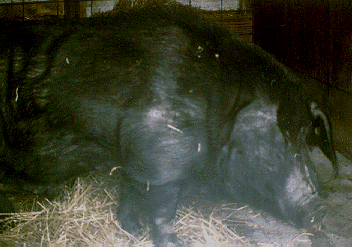 Minzhu pigs, or
Ming, Min, or Da Min, pigs come from far northern China. Minzhu means folk pig.
Minzhu pigs, or
Ming, Min, or Da Min, pigs come from far northern China. Minzhu means folk pig.They can be found in the Middle Temperate Belt, to the north of the Huaihe River Basin and the Qinling Mountains. The cold and dry climate of this region makes the Minzhu very tolerant to cold temperatures and harsh feeding conditions. They are also known as the Ming, Min, or Da Min. Minzhu is said to mean folk pig.
Minzhu pigs are small pigs with very long black hair. This hair has coarse, long bristles and a dense woolen undercoat in the winter. This hair allows sows to farrow in an open shed at 4 degrees C with issues.
Minzhu pigs are a prolific breed, though not as prolific as the other breeds import ...

 Moara
Moara
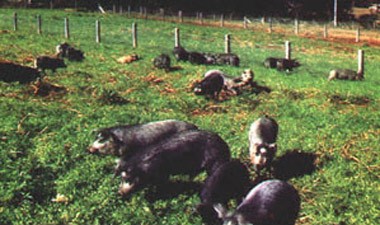 The Moara Pig, also recognized by names such as Estrela, Estrelense, Mouro, and Pereira Pig, hails from the regions of Duroc, Canastra, and Canastrao in southern Brazil. Sporting a distinctive blue roan coat, although occasionally displaying a red roan hue, these pigs boast a unique and eye-catching appearance.
The Moara Pig, also recognized by names such as Estrela, Estrelense, Mouro, and Pereira Pig, hails from the regions of Duroc, Canastra, and Canastrao in southern Brazil. Sporting a distinctive blue roan coat, although occasionally displaying a red roan hue, these pigs boast a unique and eye-catching appearance.
Renowned for their resilience and durability, Moara Pigs are esteemed for their toughness and strength. They exhibit a remarkable ability to adapt to various environmental conditions, demonstrating a remarkable capacity to thrive amidst changing landscapes. Despite their reputation for stubbornness, Moara Pigs are highly manageable, making them well-suited for small households in southern Brazil.
One of the nota ...

 Mong Cai
Mong Cai
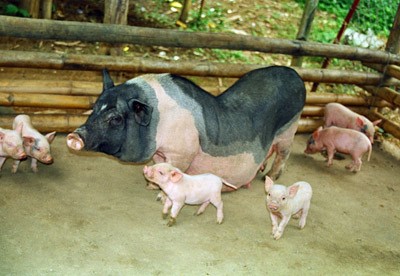 Mong Cai Pigs are one of the most common breeds of Pigs in northern
Vietnam, particularly in the provinces of North Mountain area, the Red River
delta, and the northern part of the Central Coastline.
Mong Cai Pigs are one of the most common breeds of Pigs in northern
Vietnam, particularly in the provinces of North Mountain area, the Red River
delta, and the northern part of the Central Coastline. Mong Cai Pigs are small to medium sized. Their heads are black with small and upright ears. Black patches are also found other places on their body with a white band running from one side of their abdomen over the shoulder to other side of the abdomen, making a black saddle over the middle of their concave back.
They are known for high prolificacy, good adaptation to poor-quality feed, and disease resistance. Gilts reach puberty at 2-3 months of age and they have an average litter size of 12.

 Mora Romagnola
Mora Romagnola
 Mora Romagnola
Pigs are from Emilia-Romagna, in northern Italy.
Mora Romagnola
Pigs are from Emilia-Romagna, in northern Italy. In the early 20th century there were several similar but distinct regional sub-types of Romagnolo pigs, including the Forlivese from the area o Forli, the Faentina from the area of Faenza and the Riminese or Mora Riminese from the area of Rimini. From the beginning of the century all of these types began to be crossed with British Yorkshire pigs, which were first imported to the area in 1886. First-generation crosses preserved the some of the meat quality of the local breeds, but grew much faster. By 1927 they was recognized that indiscriminate cross-breeding beyond the first generation lead to the disappearance of the local stock, and in 1941 selective br ...

 Mukota
Mukota
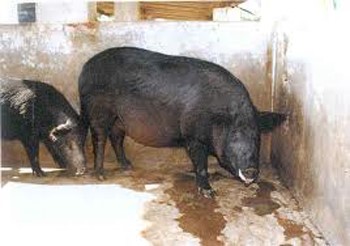 Mukota Pigs, also
known as the Rhodesian Indigenous or Zimbabwe Indigenous pigs, are primarily
found in Zimbabwe, but they also are found in Mozambique and Zambia.
Mukota Pigs, also
known as the Rhodesian Indigenous or Zimbabwe Indigenous pigs, are primarily
found in Zimbabwe, but they also are found in Mozambique and Zambia. Mukota pigs are black, hardy in the tropics, resistant to disease and poor nutrition, and require little water (6 liters per week). They fall into two broad classes. One is short and fat, with a short snout resembling that of the Chinese Lard pig. The other resembles the Windsnyer (Wind cutter) pigs, with long snout and razorback.
They are believed to have been introduced in the 17th century Europe and China trade and are named after the Mukota region of northeastern Zimbabwe.
Reproduction follows an annual rhythm with peak farrowing in ...

 Mulefoot
Mulefoot
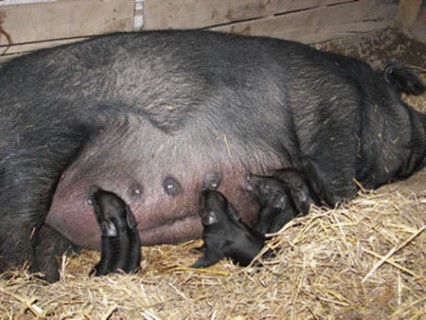 The Mulefoot pig, a rare and robust American swine breed, stands out for its hardiness and adaptability. Typically donning a sleek black coat, although occasionally featuring white markings, these pigs boast an average weight range of 400 to 600 pounds (180 to 270 kg). Males tend to tip the scales at around 550 pounds (250 kg), while females weigh in at approximately 450 pounds (200 kg).
The Mulefoot pig, a rare and robust American swine breed, stands out for its hardiness and adaptability. Typically donning a sleek black coat, although occasionally featuring white markings, these pigs boast an average weight range of 400 to 600 pounds (180 to 270 kg). Males tend to tip the scales at around 550 pounds (250 kg), while females weigh in at approximately 450 pounds (200 kg).
Thriving in pasture-based environments rather than confined feed lots, Mulefoot pigs have retained their instinctual ability to forage for food, making them well-suited for free-range farming practices. Renowned for their maternal instincts, Mulefoot sows are esteemed for their nurturing care, consistently producing litters that average 5 to 6 pi ...

 Murom
Murom
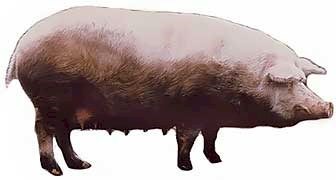 Murom Pigs are a meat and lard breed of hogs developed
in 1957 in Murom Raion, Vladimir Oblast by selection of a domestic breed.
Murom Pigs are a meat and lard breed of hogs developed
in 1957 in Murom Raion, Vladimir Oblast by selection of a domestic breed. Murom Pigs are large, sturdy, and well built. Mature boars weigh 250 - 280 kg; sows weigh 200 - 220 kg. A litter consists of ten or 11 shoats; the sow’s milk production is 60 - 70 kg. When fattened for meat, a pig at six or seven months of age will weigh 90 - 100 kg and produce high-quality bacon on the basis of 4 - 4.5 feed units per kg of weight gain.
Murom Pigs are used for commercial cross-breeding with Large Whites and other breeds.

 Myrhorod
Myrhorod
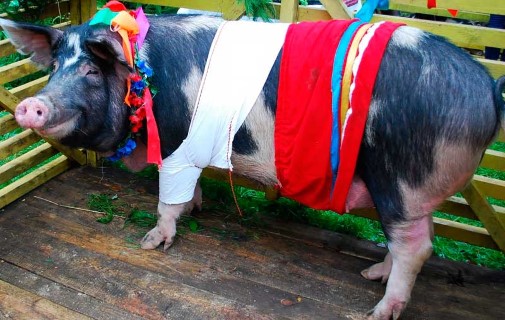 Myrhorod Pigs are a lard-type pig breed from Ukraine. They were the second domestic breed of
pig developed in Russia. Myrhorod Pigs are the result of prolonged planned work
by a large collective of scientists, specialists, and workers of collective and
state farms. They were developed through crossing of local black-ruffled pigs
with Berkshire, medium white, partially large white, Temvorskaya, and large
black pigs.
Myrhorod Pigs are a lard-type pig breed from Ukraine. They were the second domestic breed of
pig developed in Russia. Myrhorod Pigs are the result of prolonged planned work
by a large collective of scientists, specialists, and workers of collective and
state farms. They were developed through crossing of local black-ruffled pigs
with Berkshire, medium white, partially large white, Temvorskaya, and large
black pigs.Boars have an average live weight of 290 kg, a trunk length of 180 cm, and sows weigh 235 kg and 162 cm long.
Their heads are medium-sized, not coarse, snout of moderate length, and their ears are mostly short, standing, sometimes they are inclined forward. Their body is wide, with well-filled h ...
